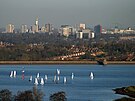From Wikipedia, the free encyclopedia
{{}}
Largest urban areas of the United KingdomUnited Kingdom Mid-2010 Urban Area Estimates [1][2][3]
|
|
|
Rank
|
Urban area
|
Pop.
|
Principal settlement
|
Rank
|
Urban area
|
Pop.
|
Principal settlement
|
|

Greater London Urban Area

West Midlands Urban Area
|
1 |
Greater London Urban Area |
8,979,158 |
London |
11 |
Belfast Metropolitan Urban Area |
579,236 |
Belfast
|

Greater Manchester Urban Area

West Yorkshire Urban Area
|
| 2 |
West Midlands Urban Area |
2,362,065 |
Birmingham |
12 |
Edinburgh |
491,360 |
Edinburgh
|
| 3 |
Greater Manchester Urban Area |
2,362,849 |
Manchester |
13 |
Brighton/Worthing/Littlehampton |
484,235 |
Brighton
|
| 4 |
West Yorkshire Urban Area |
1,616,608 |
Leeds |
14 |
Leicester Urban Area |
467,516 |
Leicester
|
| 5 |
Greater Glasgow |
1,195,200 |
Glasgow |
15 |
Portsmouth Urban Area |
463,911 |
Portsmouth
|
| 6 |
Tyneside |
908,446 |
Newcastle |
16 |
South East Dorset conurbation |
395,020 |
Bournemouth
|
| 7 |
Liverpool Urban Area |
805,578 |
Liverpool |
17 |
Reading/Wokingham Urban Area |
390,214 |
Reading
|
| 8 |
Nottingham Urban Area |
714,353 |
Nottingham |
18 |
Teesside |
373,260 |
Middlesbrough
|
| 9 |
Sheffield Urban Area |
678,577 |
Sheffield |
19 |
The Potteries Urban Area |
358,498 |
Stoke-on-Trent
|
| 10 |
Bristol Urban Area |
626,086 |
Bristol |
20 |
Cardiff Urban Area |
355,585 |
Cardiff
|
References
These will be included in the {{reflist}} of any article using this template.




